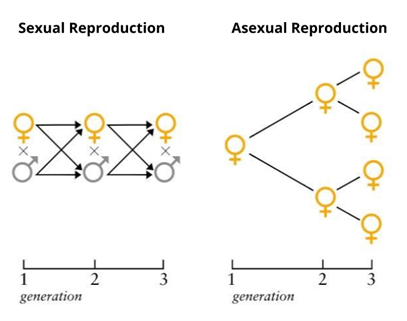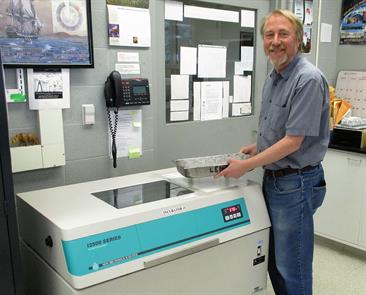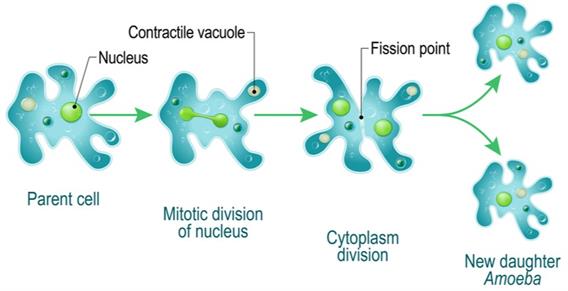
PUMPA - SMART LEARNING
எங்கள் ஆசிரியர்களுடன் 1-ஆன்-1 ஆலோசனை நேரத்தைப் பெறுங்கள். டாப்பர் ஆவதற்கு நாங்கள் பயிற்சி அளிப்போம்
Book Free DemoBefore getting into the details of variation, it's vital to comprehend and be familiar with a few key terminologies. Let's have a look at a few of them.
| Heredity |
|
| Inheritance |
|
| Variation |
|
| Asexual reproduction |
|
| Sexual reproduction |
|
| DNA copying |
|
The variations in different organisms in the same species are due to the process of reproduction.
Reproduction is creating new organisms from existing organisms of the same species. More organisms with the same basic traits as their parents are produced through reproduction.
We all know that reproduction is the only way for life to exist on this planet, and also it ensures the continuation of life on earth, and no one can deny it. Every living entity needs reproduction to continue to exist on this planet, as this process results in one or more offspring from parent organisms. The offspring produced during the reproduction process are not all identical.
However, this variation is dependent on the mode of reproduction. There are primarily two ways to reproduce.
- Sexual reproduction, which involves two parents of opposite sexes.
- Asexual reproduction, which involves a single parent reproducing itself.

Sexual and asexual reproduction
Important!
Do you know about the world's longest-running evolution experiment? 
In Michigan state university, USA, this evolution experiment is still ongoing for the past 33 years. In this experiment, scientists are studying the accumulation of variations in E.coli bacteria during their asexual reproduction. Scientists are growing E.coli bacteria in 12 conical flasks containing nutrients and allow them to reproduce.
Each day they collect the bacteria samples from the 12 flasks and store them to analyse their genetic variations, and again, the next day, they regrow them in a new set of sterile flasks. Like this, the experiment is still ongoing for the past 33 years. During these years, 74,500 generations of bacteria were grown in that lab. If we compare this with human generations, it will date back to 1.5 million years. These 74,500 generations of E.coli bacteria show the infinite number of genetic variations in them.

Dr Richard Lenski
For more information: Read here
Variation
The ability to live organisms to change their characteristics is referred to as variability.
Variation is defined as differences between individuals of the same species and offspring of the same parents.
(or)
Variation refers to the degree of dissimilarity between offspring and parents.
(or)
Variation refers to the degree of dissimilarity between offspring and parents.
In the below, we will study the types of variations that occur during asexual and sexual reproduction.
Types of variations
Variations in asexual reproduction
In asexual reproduction, only one parent is involved in the process; hence genetic material is only transferred from one parent. As a result, offspring are nearly identical to their parents. Due to this reason, there is not much variation in these types of offspring. Slight alterations are noticed due to inaccuracies in the DNA copying mechanism.
Example:
In bacteria, binary fission is a method used for asexual reproduction. During this process, bacteria, which are single cells, divide into two identical daughter cells. When one bacterium splits, the two bacteria that arise divide again, the four bacteria that result are quite similar.

Binary fission in amoeba
As discussed previously in the longest-running evolution experiment, E.coli bacteria vary every 100 or 1000 cells. These variations may look enormous, but they are very few compared to variations generated in offspring formed by sexual reproduction.
Advantages of asexual reproduction
- It involves a simple process of division and mitosis.
- It is a rapid mode of reproduction.
- A single parent can produce a large number of offspring.
- The produced daughter cells are genetically similar to their parents.
Disadvantages of asexual reproduction
- There is no variation as there is no mixing of genetic material.
- As variations do not take place, asexual reproduction has no role in evolution.
- As there is rapid multiplication, it may cause overcrowding and overpopulation.
- Organisms produced through asexual reproduction has low resistance or adaptability to a changing environment.
Reference:
https://en.wikipedia.org/wiki/Richard_Lenski#/media/File:Richard_Lenski_with_Long-Term_Flasks_and_Incubator_on_May_26,_2016.jpg
https://upload.wikimedia.org/wikipedia/commons/9/96/SexuellAsexuell.svg